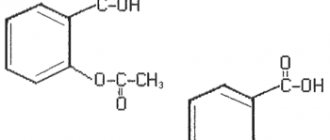Conjugated linoleic acid (CLA) is a fatty acid found in meat and dairy products that is believed to provide a variety of health benefits ().
It is also a popular weight loss supplement ().
This article looks at the effects of CLA on your weight and overall health.
What is CLA?
Content:
- What is CLA?
- What does it contain?
- CLA and Linoleic Acid: What's the Difference?
- Linoleic and lipoic acid: what is the difference
- What is the benefit of fat?
- Role in the body
- Some benefits for the body
- What products contain
- Is CLA in food good for you?
- CLA as a supplement
- Is it true that CLA helps you lose weight?
- Benefits for athletes
- When and how to take
- What forms does it come in?
- Overdose and side effects
- Use in cosmetics
CLA, or conjugated linoleic acid (CLA), belongs to the 18-carbon family of omega fatty acids. More precisely, it is a group of isomers of linoleic acid with two double bonds separated by a methyl group.
In order to understand what CLA is, you first need to understand what the term “conjugated” means, since everything is more or less clear with the other two words in the name.
So, in the name CLA, this term indicates the presence of double bonds in the fatty acid molecule. And the conjugation (conjugation) of these double bonds can occur in different parts of the molecular chain. That is, conjugated fatty acids are those whose structural formula provides for the presence of double bonds between carbon atoms.
There are 28 forms of CLA, but the most important ones are c9t11 and t10c12. The formula of each CLA isomer indicates the presence of cis (c) and trans (t) double bonds. The numbers next to the letters indicate the location of these bonds on the fatty acid chain. The difference between the forms of CLA lies precisely in the variable placement of these double bonds. And this seemingly insignificant difference can radically change the properties of the acid and its role in the body.
But there are other isomers of CLA. For example:
- 9-trans, 11-trans;
- t11,c13;
- 8t10c;
- 9-hydroxy-trans 12-cis (source – Valerian Fori, teardrop seeds).
By the way, there is reason to believe that the latter isomer suppresses fat accumulation 8 times better than the basic isomer t10c12. And the 13-oxo-CLA isomer has twice the biological activity of c9t11.
Thus, CLA is a type of polyunsaturated fatty acid with cis and trans double bonds. In other words, CLA is technically a trans fat, but it is a naturally occurring trans fat and is found in many healthy foods. Scientists have conducted many studies and they all confirmed: while industrial trans fats are harmful to humans, natural CLA are not.
What is the effective dose
The effective dose of CLA is 3.4 grams per day. As mentioned above, the most effective are the cis-9, trans-11 or trans-10, cis-12 forms. A popular brand name that contains both types of these CLA chains is called Tonalin. This is a really popular patented formula. Interestingly, taking more CLA does not lead to better results.
If you take conjugated linoleic acid, you need to start with 3.4 grams per day for a week. If there is no result, you can slightly increase your intake next week. For larger people, doses may be slightly higher. Mostly determined by trial and error, but in general the effective dosage is 3.4 grams or a little more.
What does it contain?
CLA is produced naturally in the digestive tract of ruminants and to a lesser extent in pigs and poultry. Under the influence of fermentation bacteria Butyrivibrio Fibrisolvens, linoleic acid is transformed into CLA. The most well-known isomers of CLA and the ones most commonly found in foods are 11-trans 9-cis. But the human body is not capable of producing CLA, so it uses dairy products and meat as a source of this beneficial substance. However, there is an exception to this rule: CLA is found in human milk. And this fact, according to scientists, is the best possible confirmation of how important this compound is for humans. After all, only substances important for human life are concentrated in human milk.
In addition, industrial production of CLA is also possible. But how is linoleic acid conjugated and why is it needed? This substance can be obtained through chemical treatment - as a result of partial hydrogenation of linoleic acid. More precisely, CLA is the result of an alkaline effect on vegetable oils, which contain large reserves of acid “raw materials”. The result is compounds with very high biological activity and a specific chemical composition.
CLA and Linoleic Acid: What's the Difference?
Linoleic acid is the most abundant omega-6 fatty acid. It is considered essential for humans, enters the body with food, and is then transformed into a substance known as arachidonic acid. Mainly found in vegetable oils, but also found in other foods.
And while CLA is technically a “version” of linoleic acid, it’s important not to confuse the two. At least when it comes to the effect on the body. Chemically, they are different compounds and have opposite properties. So, what is the difference between CLA and linoleic acid?
While linoleic acid (found in cottonseed oil and other plant foods) stimulates the formation of fatty tissue (a process known as lipogenesis), CLA, on the contrary, causes lipid oxidation, thereby inhibiting the accumulation of subcutaneous deposits. Another difference is the ability to influence the formation of tumors. If researchers consider linoleic acid as one of the substances that promotes the malignant degeneration of cells, then CLA has repeatedly confirmed its ability to inhibit the development of cancer. And finally, one more important difference. Linoleic acid sometimes helps increase blood cholesterol, and CLA, as you may have guessed, removes excess cholesterol and triglycerides from the body.
Scientists continue to study the properties of both substances, but already have many reasons to claim: an excess of linoleic acid against the background of a CLA deficiency can be dangerous to health.
Linoleic and lipoic acid: what is the difference
And one more note. When talking about the benefits of fatty acids, it is also important to distinguish between linoleic and lipoic acids. Although the names of both substances may seem similar to some, in fact they are different chemical components.
Lipoic acid is also known as vitamin N or thioctacid. It, like CLA, is found in red meat, but in addition, it is found in spinach, broccoli, potatoes, carrots, and yeast. Nutritionists strongly recommend not consuming it together with fatty acids (including linoleic acid); instead, it is better to combine it with another popular sports nutrition supplement - L-carnitine.
Linoleic acid, like gamma-linolenic acid (GLA) and arachidonic acid, is a member of the PUFA class (polyunsaturated fatty acids). A person needs this substance from birth, since the development and functioning of many organs depends on this acid. And if you analyze where this substance is found, then vegetable oils come to mind first. It is found in sunflower oil, corn oil, olive oil, safflower oil, flaxseed oil and many other products from this group. And it is this substance that serves as the source of conjugated linoleic acid.
Impact on the body
Conjugated linoleic acid, its properties and effects on the body have not been fully studied, and the process of losing weight largely depends on human behavior, including eating. Losing weight, as well as building muscle mass, is possible only if you follow a diet and regular physical activity.
It has been experimentally proven that a person who uses drugs containing CLA loses more fat tissue than the “average” (up to 800 g per week). This is explained by the fact that when using it:
- Accelerates the fat burning process;
- the amount of calories consumed decreases due to decreased appetite;
- the process of formation of adipose tissue slows down;
- metabolism accelerates;
- more intensive breakdown of triglycerides occurs.
What is the benefit of fat?
All types of lipids (from meat, eggs, dairy products, butter or vegetable oil, nuts, seeds) consist of fatty acids, the benefits and harms of which depend on various factors.
Polyunsaturated fatty acids (alpha-linolenic, linoleic, eicosapentaenoic, docosahexaenoic, conjugated linoleic) are important for athletes, monounsaturated (oleic, palmitic) are important for the cardiovascular system. But trans fats, like saturated palmic fatty acid or sterolic acid, usually have contraindications, so you should be careful with them.
Meanwhile, some of these substances are essential for humans, and their deficiency (especially during pregnancy) can have serious consequences. These include polyunsaturated omega-3 fatty acids (found in fish, seafood, eggs, some nuts and seeds) and omega-6 fats (mainly concentrated in vegetable oil, nuts, and seeds).
Both types of fatty acids play different roles in the body, but their balance is extremely important. Their correct proportions are necessary for the healthy functioning of the immune system, maintaining hormonal levels, and the functioning of the digestive and nervous systems. Ideally, the human body should receive more omega-3 and less omega-6. But in reality, everything happens the other way around.
The basis of omega-6 fats is called linoleic acid, which is found in cereals and vegetable oils (for example, corn, safflower, sunflower, canola). It is now known that excessive consumption of these omega-6 foods can have unwanted health effects.
Conjugated linoleic acid, in its effect on the body, is more reminiscent of omega-3 than omega-6, of which it is actually an isomer. In particular, CLA has anti-inflammatory properties, and is also able to “turn off” hunger, so to speak, by influencing the production of ghrelin (the hunger hormone).
Summarize
- Research shows that conjugated linoleic acid (CLA) has only a modest effect on weight loss.
- Although it does not cause any serious side effects in doses up to 6 grams per day, there are concerns about the long-term health effects of taking the supplement.
- Losing a few pounds of fat may not be worth the potential health risks, especially since there are better ways to lose weight.
Tags: Conjugated linoleic acid
- Related Posts
- Can Thermogenic Fat Burners Help You Burn Fat?
- Fiber: what is it and what is it for?
- Omega-3 fatty acids: what they are, their role, food sources
« Previous entry
Role in the body
Scientists discovered the biological activity of CLA in 1987. At that time, researcher Michael Parise discovered that when minced meat was exposed to high temperatures, substances were formed in the product that prevented muscle cell mutations. Experiments on mice have proven the effectiveness of these polyunsaturated acids in the fight against malignant tumors. Later, other researchers discovered that these substances can also reduce body fat percentage. And since obesity is one of the main problems of modern humanity, scientists became interested in the potential abilities of CLA to increase the effectiveness of weight loss programs.
Today it is already known that this substance:
- reduces body fat;
- increases insulin resistance (and therefore can prevent diabetes);
- has antithrombogenic and anticancer properties;
- prevents atherosclerosis;
- improves lipid profile;
- modulates the immune system;
- promotes bone mineralization;
- reduces blood glucose levels;
- improves digestion;
- helps fight food allergies.
However, the most studied property of CLA supplementation is its ability to reduce fat mass and increase muscle mass.
Benefits and harms of the substance
CLA has a number of beneficial properties. But, like any other supplement, if the instructions are not followed, it can cause harm. This natural substance has a powerful anticarcinogenic and antioxidant effect. In general, it has a beneficial effect on the digestive system, takes an active part in the synthesis of fats and proteins, and allows you to speed up metabolism, which is very important for losing weight. Conjugated linoleic acid is extremely necessary for the body, as it has a stimulating effect on the immune system, and, as a result, reduces the risk of acute viral diseases.
The substance actively fights fat formed on internal organs, promoting the growth of lean muscle mass, improves the condition of nails, hair and skin, ensures the proper functioning of the cardiovascular and neuroendocrine systems, actively participating in the synthesis of prostaglandins. Supports the reproductive system.
Despite the fact that omega-6 is a substance that has only positive properties, it can also have negative effects. R. Brown in 2009 conducted a series of clinical studies and described that abuse of this substance will inevitably lead to the development of pathologies such as stroke, heart attack and even cancer.
Some benefits for the body
Regulates cholesterol and blood glucose levels
As it turns out, CLA is a good remedy for combating the increase in bad cholesterol, thereby preventing atherosclerosis, hypertension, heart and vascular disease.
Research has also confirmed the existence of a link between CLA consumption and the risk of diabetes. It turned out that CLA lowers blood sugar and increases the body's sensitivity to insulin.
Supports immunity
People on low-calorie diets are more susceptible to disease. And all because, without receiving enough nutrients, the body becomes more vulnerable, the immune system weakens. Introducing CLA into the diet will strengthen the immune system and also prevent the catabolic effects of the immune system during illness.
Prevents cancer
Conjugated linoleic acid has anti-cancer properties. This statement was made by experts after a series of experiments on animals. In addition, some claim that CLA may be beneficial in preventing breast, prostate, and digestive cancers. Penetrating into mutated cells, CLA molecules program them to die (apotosis).
Protects against allergies
After 12 weeks of using the dietary supplement CLA, the participants confirmed that their seasonal allergy symptoms decreased. Scientists have also noticed that CLA is beneficial for people with asthma. Against the background of this fatty acid, the patients' health status significantly improved and the sensitivity of the respiratory tract decreased.
Reduces joint pain
Research has shown that CLA is also beneficial for people with rheumatoid arthritis. The supplement in combination with vitamin E reduces joint pain, swelling and other symptoms of the disease. In this regard, scientists suggest that CLA could serve as a treatment for joint disease.
Beneficial features
At this stage of research, it has been revealed that conjugated linoleic acid (CLA) is capable of:
- accelerate the body's metabolism;
- help increase muscle mass;
- reduce cholesterol levels;
- reduce the risk of developing diabetes through insulin resistance;
- increase immunity;
- has a beneficial effect on reducing the incidence of food allergies.
CLA drugs inhibit the process of fat accumulation, especially in the peritoneum (visceral) area. This type of fatty deposits, which can invade the liver, heart and blood vessels, is very dangerous and often leads to heart attacks, strokes, thrombosis and other troubles. CLA increases the sensitivity of muscle cells to insulin, so fat and glucose pass through the membranes more actively, without being stored “in reserve.” As a result, the percentage of fat decreases and muscle mass increases.
- Helps strengthen the immune system and increase the body's resistance to various diseases.
- Reduces the likelihood of allergic reactions.
- Accelerates metabolic processes, which is doubly important for those who want to lose extra pounds.
- Helps reduce the time it takes to build muscle mass. This is a priority for bodybuilders.
- Reduces insulin resistance, which is a kind of prevention of diabetes.
- Normalizes triglyceride and cholesterol levels.
- Prevents the appearance and development of atherosclerosis.
- Helps cover the body's need for minerals.
- Improves digestive processes.
- They do not allow the breakdown of protein compounds that make up muscle tissue.
What products contain
CLA in its natural form has been found in many foods, in particular from the meat and dairy group.
It is well known that the main sources of CLA are animal products. The highest content of this substance was found in kangaroo meat, slightly less in the meat and milk of ruminants (cows, goats, sheep). Meanwhile, the concentration of CLA in these products largely depends on what the animals ate. For example, CLA content is sometimes 3 to 5 times higher in beef and dairy products from grass-fed animals than from those whose diets were dominated by grains and animal feed. Table of CLA content in food
| The product's name | CLA content (mg) per 100 g fat |
| Beef (pasture raised) | 2100 |
| Swiss cheese | 660 |
| Mutton | 560 |
| Cow's milk | 550 |
| Butter | 470 |
| Yogurt | 470 |
| Sour cream | 460 |
| Cottage cheese | 450 |
| Beef | 420 |
| Cheddar cheese | 360 |
| Turkey | 250 |
| Sunflower oil | 100 |
| Linseed oil | 100 |
| Chicken | 90 |
| Pork | 60 |
| Chicken yolk | 60 |
| Salmon fillets | 30 |
But the data indicated in the table is approximate, and these data may differ in meat from different manufacturers. The fact is that the concentration of CLA in meat and milk directly depends on the animal’s diet. The more frequently livestock consumed fresh grass, the higher the CLA. For this reason, meat from confinement-raised cows may not be a good source of conjugated linoleic acid.
Moreover, American scientists have calculated: modern veal (and these data are indicated in the table) contains only a third of the CLA values that were in the meat of the 1960s.
Pharmacology
Distribution
In a study of 22 healthy Japanese subjects with a mildly overweight body mass index of 20/-0.4, taking 2.2 g CLA daily for 3 weeks (47.3% c9t11, 50.7% t10c12) was able to significantly increase CLA content in red blood cells. blood cells and plasma almost four times compared to 2.2 g of linoleic acid.
At the same time, red blood cells contained 0.06% of total fatty acids such as CLA in the control, and after 4 weeks in the test group they were observed in the range of 0.31-0.5%; The plasma content of total fatty acids increased from 0.12% to 0.26-0.92%. Increases in CLA levels in lipoproteins (high-density, low-density, very low-density) were also observed after 4 weeks, although the blood concentrations of these lipoproteins did not change significantly.
A study using a similar dose found the same trends, but slightly smaller changes in the blood of Irish people. Requires more than 1 week to form reserves in the body and remains in the body for at least one week after stopping use; is withdrawn 2 weeks after stopping treatment.
Is CLA in food good for you?
The natural version of CLA, as already mentioned, is found in meat and dairy products. Researchers studying the properties of CLA have never overlooked the natural version of the fatty acid. And after long-term observations, we made several conclusions.
First, people who eat plenty of foods containing CLA are less likely to develop some chronic diseases, including type 2 diabetes and cancer.
Secondly, research has shown that in regions where cows eat grass as their main diet, people get more CLA and are less likely to suffer from heart disease. Although not everyone in the scientific world agrees with this assumption. Some do not attribute these results to the CLA.
As for CLA's most well-known fat-burning ability, it turns out that the c9t11-type isomer (found in foods) is less beneficial for this purpose than the "chemical" version of CLA.
CLA as a supplement
To experience all the benefits of this acid, food alone is not enough. In addition, foods containing CLA also tend to be high in saturated fat (aka bad fat). The researchers calculated that if someone tried to get at least 3 g of CLA from food alone, they would inevitably have to consume almost half a kilo of fat along with nutrients, which is more than 4,500 kilocalories.
And then dietary supplements come to the rescue. The CLA sports supplement is a way to get the fatty acid in its pure form, while eliminating the intake of excess calories. The active ingredient in supplements is most often obtained from safflower seeds or sunflower oil. As a result of chemical exposure to these products, the linoleic acid contained in them is converted into conjugated acid.
By the way, there is a certain difference between CLA contained in food products and those included in dietary supplements. While the c9t11 isomer is usually present in food, food additives are a substance whose structural formula is t10c12. This means that there is every reason to believe that both versions of CLA have different effects on the body.
What doctors say about using the product for weight loss
Compared to many dietary supplements that are used to lose weight and shape your figure, CLA is completely safe. It should not be taken only by pregnant and lactating women, as well as children under 18 years of age.
Since linoleic acid is a substance of natural origin, which is found in food products familiar to humans, allergic and other negative reactions due to intake are observed in very rare cases. Almost everyone can take this remedy, but some requirements must be met:
- CLA is taken in courses of 2-3 months, then a pause is made, the duration of which is determined by the attending physician;
- When using the drug to lose weight, you should stop drinking alcohol;
- To achieve the desired effect, linoleic acid must be taken pure, and not as a component of any product (for example, Reduxin);
- CLA should be taken in combination with physical activity, otherwise results cannot be achieved.
CLA during weight loss is characterized by a pronounced effect even if severe obesity appears. However, you should take it correctly, and you also need to eat right and lead an active lifestyle.
Linoleic acid is sold in pharmacies, online, and in sports nutrition stores. It is represented by various dietary supplements containing CLA. The cost of drugs is determined by the manufacturer and form of use. CLA in its pure form costs more than a vitamin complex. If you believe the reviews about the product, then it is more profitable to order the product in an online store.
The price for drugs containing CLA is as follows:
- Tropicana Slim in the form of capsules (90 pieces) 1020-1100 rub.;
- Fitmiss Tone in the form of capsules (60 pieces) RUB 983;
- SAN Lipidex in the form of capsules (180 pieces) 2600-2700 rub.;
- Optimum Flaxseed Oil powder (100 servings) 320 rub.
Preparations with similar composition:
- "Linofit";
- "Reduxin light" in capsules;
- “Chocolate of life” in powder form.
Analogues of foreign manufacturers: Zerofat, CLA, CLAextrim and others.
Source https://mirdieta.ru/preparaty/linolevaya-kislota.html
Alpha-linoleic acid is classified as an essential amino acid; it has a very useful isomer - conjugated linoleic acid, otherwise called CLA. Recent studies have shown that it has a number of unique properties, therefore it is used in medicine, cosmetology and to adjust the sports diet.
Is it true that CLA helps you lose weight?
But still, CLA owes its extreme popularity to its ability to accelerate weight loss. Many may wonder: how can fat be beneficial in the fight against fat? Actually it can! Especially when it comes to essential fatty acids like CLA. Over the years of testing, scientists have conducted many studies using CLA. Some even suggest that it is one of the most researched weight loss substances in the world.
Scientists have determined that consuming CLA triggers a series of biochemical reactions in the body that speed up basal metabolism. Many studies indicate that CLA is more effective when it comes to obese individuals. But this substance can also effectively reduce body fat in healthy people.
Many studies have confirmed that CLA can cause significant fat loss. In addition, it has been confirmed that CLA not only gets rid of the lipid layer, but also improves the condition of muscle mass, in many cases increasing it. However, there are also results from other studies that either did not confirm the fat-burning effect of CLA, or the results when taking the supplement were insignificant.
An independent group of scientists examined data from 18 studies and reached their conclusions. So, the most pronounced effect of taking CLA is usually observed in the first 6 months of using the supplement. Then, over the next 2 years, efficiency slowly decreases, eventually reaching a so-called plateau period. The same researchers estimated that during the first six months of taking the supplement, the body can lose up to 100 grams of fat every week.
American scientists conducted an experiment in which participants were divided into two groups: healthy people and obese people. Participants in the experiment without excess weight took 4.2 g of CLA daily, and representatives of the second group drank 3.4 g of the supplement. After 12 weeks, both groups appeared to have lost quite a lot of fat. In addition, obese people are almost 4 percent more likely.
Another study was conducted with the participation of novice bodybuilders. They drank 7.2 g of CLA during training for 6 weeks. The result (compared to the control group that did not take the supplement) was a noticeable increase in muscle mass.
CLA was also tested in Sweden. There, 25 obese men aged 39 to 64 years participated in the experiment. They took 4.2 conjugated linoleic acid daily for 4 weeks. After the time allotted for the experiment, it turned out that on average each of them had lost one and a half centimeters in waist circumference.
Previously, researchers assumed that the ideal fat-burning complex is a mixture of equal parts of isomers t10c12 and c9t11. But in the process of research, they discovered that it is the t10c12 isomer that is responsible for preventing obesity.
Interestingly, CLA has confirmed its effectiveness in the treatment of so-called male obesity (“apple” type, when fat accumulates in the abdominal area). Researchers consider this an important discovery, since this type of obesity is more difficult to treat and is considered one of the factors that increases the risk of developing diseases such as diabetes, atherosclerosis, autoimmune diseases, hypertension, and dysbiosis. And it is this type of obesity that causes an increase in cholesterol and triglycerides in the blood.
By the way, only after carefully studying the properties of CLA and L-carnisone, many agreed that the Atkins diet (developed by nutritionist Robert Atkins) is indeed effective. Meat, butter and dairy products are not dangerous for your figure, unless you fry them and combine them with foods with a high glycemic index.
Effect of CLA on weight loss
Its effectiveness is undeniable, but there are some reasons why people sometimes do not achieve the desired fat-burning result.
Not taking enough
There is no calorie deficit - in this case the supplement will not work.
This means that conjugated linoleic acid does not work for everyone. However, research proves its effectiveness.
For example, a 12-week study of 67 overweight men found that taking conjugated linoleic acid resulted in significant fat loss. All participants were divided into a supplement group and a placebo group. Significant burning of total and subcutaneous fat was observed in the CLA group.
Another 12-week, double-blind study found that those taking CLA lost more fat.
In this particular study, 60 participants were divided into 5 groups as follows:
- 1.7 g per day;
- 3.4 g per day;
- 5.1 g per day;
- 6.8 g per day;
- placebo.
X-ray absorptiometry was used to measure body fat before and after the study. Researchers observed significantly greater amounts of body fat loss in those taking CLA, especially in the groups that took 3.4 and 6.8 grams per day.
It's important to note that some of the research is a bit confusing.
For example, there are several other studies on CLA that found no effect from taking the supplement. The main limitation of these studies was that all subjects were not in a caloric deficit. Therefore, the result was not achieved due to an improperly balanced diet.
Benefits for athletes
Many people know that CLA effectively reduces body fat. Meanwhile, at one time, researchers noticed that often against the background of a decrease in the fat layer, the total weight does not decrease, and sometimes even increases. And scientists have found an explanation. It turns out that in addition to burning fat, CLA plays another role - it improves muscle growth.
CLA is more often thought of as a fat-burning product, but research has also confirmed that CLA is important for individuals looking to build muscle mass. It is believed that conjugated linoleic acid (alone or in combination with supplements such as creatine and whey protein) promotes muscle growth and strengthening. For this reason, sports nutrition, along with many other products, also includes CLA. This substance is included in some protein shakes and, of course, it is included in the formulas of weight loss drugs. It is believed that the effect of taking the drug is better noticeable when drying.
The researchers conducted the experiment with the participation of 76 volunteers. Participants in the experiment received 5 g of CLA daily for 7 weeks and were engaged in a program consisting of strength exercises 3 times a week. After the time allotted for the experiment, it turned out that the athletes who consumed CLA had increased muscle mass by almost one and a half kilograms. While the results of the control group that did not use the supplement were only 200 g. Also, while taking CLA, athletes experienced a significant decrease in body fat (some lost up to 800 g of fat). In addition, the experiment participants who took the supplement showed better results during strength exercises.
Conjugated linoleic acid is useful for people who:
- strength training;
- fitness;
- swimming;
- running;
- race walking;
- dancing and other sports.
Why take conjugated linoleic acid?
The main reason is its effect on improving body composition. While most people believe that CLA helps burn fat, there is also ample evidence that it helps maintain and even gain muscle mass without fat. It should be noted that this is not a magical dietary supplement. In other words, if you eat many more calories than you burn, CLA won't help! The basis of weight loss is a calorie deficit. However, during the cutting phase, it is used in conjunction with various other fat burners to speed up fat loss while maintaining muscle.
CLA is thought to work by stopping the growth of individual fat cells. In other words, conjugated linoleic acid limits their size so that fat cannot enter the fat cell and be stored there. That is, during the “drying” period, additional fatty acids cannot be stored in the cell and therefore are simply burned as fuel.
Taking it along with caffeine or green tea extract helps flush out these free-floating fatty acids. That is why it is often included in many fat-burning dietary supplements along with a huge number of other ingredients. However, there are other mechanisms of fat burning when taking conjugated linoleic acid, but many of them are still not fully understood.{banner_st-d-1}
When and how to take
CLA is considered a safe substance for humans, so it can be included in the diet of men and women of different ages. Experts estimate that for effective fat burning you will need from 1.8 to 7 grams of CLA per day, and most studies have confirmed the safety of doses ranging from 3.2 to 6.4 grams of the substance per day.
Meanwhile, the optimal regimen for burning fat involves taking 0.6-2 g of CLA twice or three times a day (can be taken at any time of the day without reference to meals). The dose is adjusted individually, taking into account the stage of obesity or the amount of fat that needs to be eliminated. It is not recommended to take more - the effect of taking large doses will not affect the rate of weight loss or muscle building. But alcohol can affect the chemical properties of the drug (and therefore the expected result). For this reason, you cannot combine both substances. It is also important to know that CLA enhances the fat-burning properties of fucoxanthin. For this reason, both substances are considered highly compatible. But it is better not to combine CLA with fat blockers and resveratrol (they have opposite properties). And to completion. To actually feel the result, conjugated acid will have to be taken for 2-3 months, and also against the background of physical activity.
What forms does it come in?
Typically, CLA in the form of a sports supplement is in tablets and capsules, and is also found in mixtures for athletes. But conjugated fatty acids in capsules are considered optimal for the body.
Today, supplements containing CLA are a very affordable product that can be purchased both in sports nutrition stores and in pharmacies. In addition, the supplement is presented in different forms: in its pure form (for example, Solgar) or in combination with other beneficial substances. Most often, manufacturers add vitamins and minerals (in particular, group B substances, iodine, manganese), mineral salts, proteins, and other fat-burning substances.
Among the representatives of the second group is the fat burner “Tropicana Slim”, the capsules of which contain CLA and tocopherol concentrate. Another interesting option is CLA in the form of the Vitime Body Sculptor chocolate-caramel cocktail. In its composition, in addition to conjugated linoleic acid, the manufacturer introduced three types of proteins (whey, soy and casein micellar), vitamin C and manganese. The sports nutrition supplement Lipo Star System is also popular. The manufacturer declared that this drug contains CLA, L-carnitine and ginger extract (known for its ability to speed up metabolism and burn subcutaneous fat).
That is, the market offers both expensive drugs with a rich chemical composition and cheaper analogues consisting of pure CLA, the effect of which is usually identical. But still, the scheme and amount of supplements taken from different manufacturers may differ significantly. What exactly is included in the dietary supplement and how to take the drug will be explained in the instructions for use, which cannot be ignored (especially if you want to take the drug for several months).
And further. When choosing a sports nutrition supplement containing CLA, it is important not only to pay attention to the name of the product, but also to the manufacturer. Today on the market you can find at least a dozen products with the identical name - CLA. Among the most popular are those produced by such companies as Dymatize, Optimum Nutrition, Multipower, Trec Nutrition, Performance, Muscletech, Amway NUTRILITE, IronMaxx.
Main conclusions
When used correctly, CLA can be quite effective.
At least this supplement reduces the amount of fat in the body. However, this does not mean that it is guaranteed to help you even when taken at the correct dosage (approximately 3.4 grams per day). As we've discussed, the research on this supplement is a bit confusing and some have found no significant benefits.
Regarding side effects: CLA is generally well tolerated, but it is important to remember to drink plenty of fluids when taking this supplement as it draws a lot of fluid from the body's cells.
When taken with conjugated linoleic acid in combination with caffeine, green tea, L-carnitine and other ingredients, they are guaranteed to have a cumulative effect on fat burning.
Overdose and side effects
There is a lot of evidence that CLA is beneficial for the body. However, it is important to remember that some nutrients that are beneficial in small quantities can be harmful if taken in large doses. Abuse of conjugated linoleic acid also poses certain dangers.
Research shows that large doses of CLA can lead to fat accumulation in the liver, which increases the risk of developing metabolic syndrome and diabetes. Animal and human studies have also shown that large servings of CLA may lower good cholesterol levels. In addition, an overdose of CLA also causes less serious side effects: diarrhea, abdominal pain, flatulence, nausea.
As for children and pregnant women, it is better not to take conjugated linoleic acid preparations for them. But that doesn't mean there shouldn't be natural sources of CLA in their diet. On the contrary, products containing CLA are beneficial for both children and expectant mothers.
Best materials of the month
- Why you can't go on a diet on your own
- 21 tips on how to avoid buying stale food
- How to keep vegetables and fruits fresh: simple tricks
- How to curb your sweet cravings: 7 unexpected products
- Scientists say youth can be extended
CLA can be dangerous for people after surgery, with liver disease, and blood clotting disorders. Conjugated linoleic acid may slow blood clotting and thereby increase the risk of bruising and bleeding. But this again applies exclusively to CLA in the form of dietary supplements, and not to meat and dairy products. In addition, any instructions for use of the supplement contain a complete list of contraindications and side effects.
TOP 5 best dietary supplements for weight loss
"Reduxin Light"
The manufacturer offers two types of capsules: “Strengthened formula” (contains 650 mg of CLA) and regular capsules containing 625 mg of active ingredient. The drug contains: Chinese yam root and extract, tocopherol, 5-hydroxytryptophan. Reception of "Reduxin Light" is carried out in accordance with the instructions.
Read more: What vitamins are best to inject to boost immunity?
CLA Softgel Caps
One capsule contains 1000 mg of the substance, and an increased amount provides a more intense weight loss process and protects muscles from weight loss. It is not recommended to exceed the recommended dose, so the manufacturer advises taking no more than 3-4 capsules per day. The composition, in addition to the main active ingredient, includes: beeswax, green tea extract, soybean oil.
Pharmaceutical product containing glycerin, gelatin, vitamin mixture and conjugated linoleic acid (650 mg), presented in active form. It is recommended to take the drug for no more than three months in a row, then take a break for several months.
Nutrex Lipo 6 CLA
The active component is contained in an amount of 750 mg, which means that to cover the daily requirement for CLA, you need to consume 4-6 capsules. This should be done an hour before meals or 2 hours after meals, washed down with water. That is, it is necessary to ensure the bioavailability of the nutrient.
Magnum Acid
A drug that accelerates metabolism and the fat burning process. One capsule contains 1700 mg of CLA, which is equivalent to 6 liters of natural milk. Therefore, just two units will be enough to cover the daily requirement for this substance. Reception is carried out in the morning and evening hours.
Use in cosmetics
The antioxidant properties of CLA make it a useful component of cosmetics. Just like alpha lipoic acid, gamma linolenic acid and oleic acid, this fatty acid is used in facial and hair products. In particular, skin cream, which contains polyunsaturated fatty acids, has anti-aging properties, moisturizes, tones and tightens the skin, promotes its regeneration, and soothes inflammation. Conjugated linoleic acid is considered beneficial for any skin type, but it is most needed for dry skin, and is also indispensable for caring for the area around the eyes. In cosmetology and pharmaceuticals, this substance plays the role of one of the main anti-aging components and is used as a medicine against itching caused by various diseases. The use of masks containing fatty oils with CLA is useful for people with weakened hair that has lost its shine, as well as for the treatment of dandruff.
Conjugated linoleic acid is an important component in the diet of any person who cares about their health and appearance. Do you exercise intensively, but it is difficult to see the beautiful relief under a layer of fat that just doesn’t want to go away? Most likely, it's time to reconsider your diet. And of course... CLA to help you!
More fresh and relevant information about health on our Telegram channel. Subscribe: https://t.me/foodandhealthru
We will be grateful if you use the buttons:











